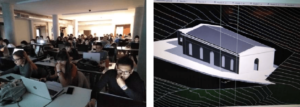Eneko J. Uranga
Iñigo León
Maialen Sagarna
Leire Azcona
Lauren Exepare
Innigo Lizundia
Itziar Rodriguez
The objective of this Project is the progressive implementation of the BIM methodology in the Degree in Fundamentals of Architecture, and specifically, in this second phase corresponding to the year 2019 an analysis of the resources available to the Degree and what subjects can be key when establishing a route throughout the 5 courses that the Degree lasts. It must be taken into account that the current Curriculum includes some contents per subject that should not be replaced in any case by the implementation of this new methodology. Furthermore, the BIM method must be incorporated into the contents of the subjects where it is considered appropriate to implement them. For this, three analyzes have been developed that help to better understand the reality of the Degree and the relationship it may have with the BIM methodology:
– Analysis and comparison of BIM competencies with those existing in the Degree.
– Analysis of the necessary human resources that can allow the implementation.
– Analysis of key subjects that can develop BIM skills.
These are the objectives of this second phase, to analyze how the Degree works at present and to observe how the BIM methodology could be implemented without having to change the Study Plan and its content, or ultimately, to observe if in a future Possible revision of the Study Plan, how to contemplate implementing this BIM methodology.
In addition to the research study to see how the BIM methodology can be implemented in the Degree, another of the main objectives of this phase is to begin to apply this knowledge in the current Degree. On the one hand, so that the students who are currently studying the Degree do not miss the opportunity to receive a minimum knowledge. On the other hand, to be able through an empirical method that the movement is demonstrated by walking. In this way, while theorizing about what should be the best way to implement BIM, it is experimented by applying this same methodology.




